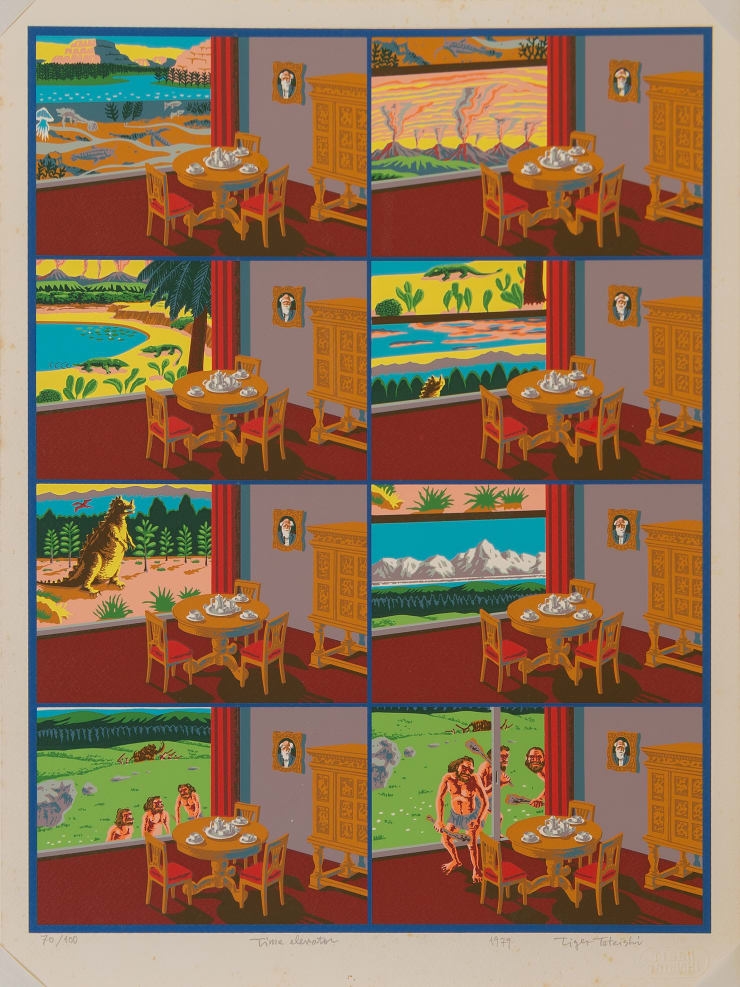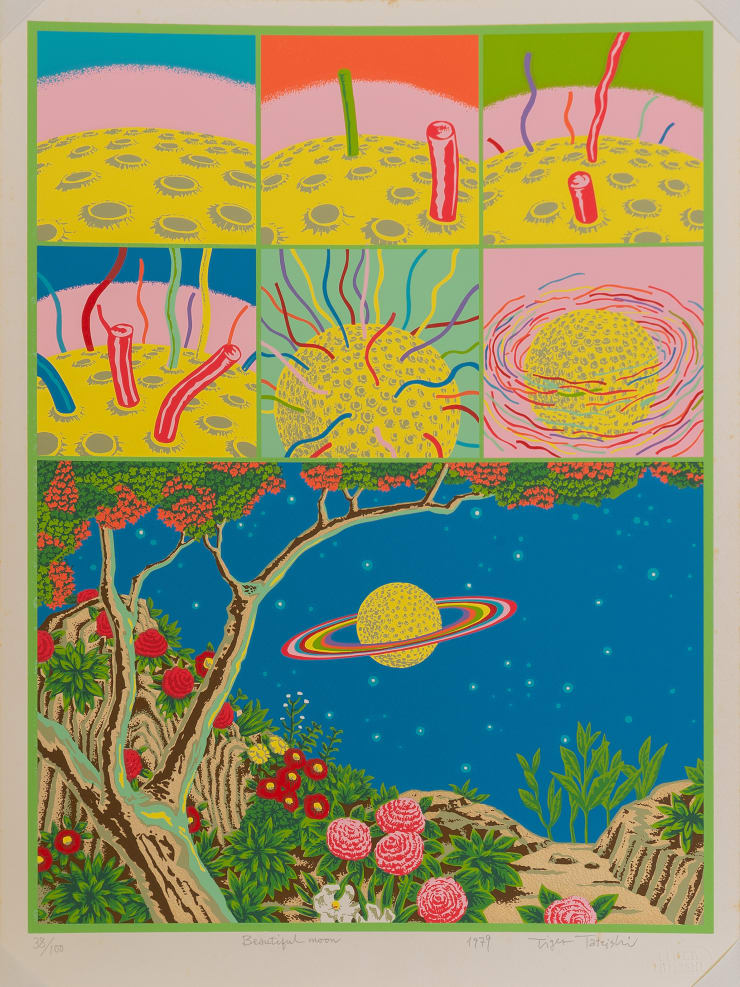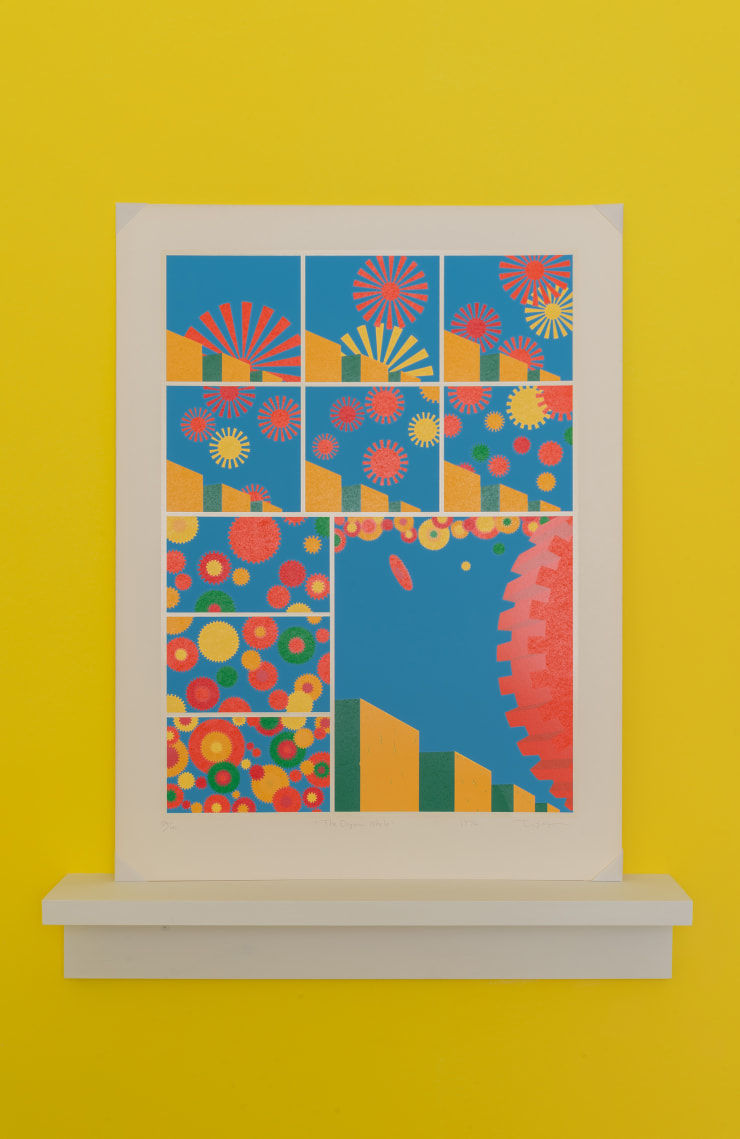Tiger Tateishi
Tiger Tateishi, born Kōichi Tateishi (立石紘一) on December 20, 1941, in Ida, Chikuho (now Tagawa City, Fukuoka Prefecture, Japan), was a multifaceted Japanese artist renowned for his contributions to painting, manga, illustration, picture books, and ceramics. Growing up during Japan’s postwar reconstruction and rapid economic growth, Tateishi was immersed in the vibrant cultural landscape of Showa-era songs, American movies, Disney cartoons, and science fiction, which profoundly influenced his eclectic and imaginative oeuvre. His pen name “Tiger,” adopted in 1968 and written in katakana (タイガー立石) to evoke a Western flair, reflected his birth in the Year of the Tiger and became a recurring motif in his work, symbolizing both personal identity and cultural commentary.
Tateishi graduated from Musashino Art University’s Junior College of Art and Design in 1963, marking the start of his artistic career. That same year, he debuted at the 15th Yomiuri Independent Exhibition with a large-scale collage relief titled Community, which garnered critical acclaim for its innovative use of tin toys and driftwood. Embracing the avant-garde, he co-founded the Sightseeing Art Research Institute (1964–1966) with painter Hiroshi Nakamura, producing works that parodied Japan’s tourism boom during the 1964 Tokyo Olympics. His early paintings, often categorized as Japanese Pop Art, collided national symbols like Mt. Fuji, Godzilla, and samurai with global icons such as Mao Zedong, Coca-Cola, and the Ku Klux Klan, offering a satirical lens on Japan’s modernization and global influence.
In 1965, Tateishi began creating nonsense manga under his pen name, influenced by his friend and collaborator Fujio Akatsuka. His manga, characterized by whimsical humor and surreal narratives, introduced the popular catchphrase “nyarome.” In 1969, seeking creative stimulation, Tateishi relocated to Milan, Italy, where he lived for 13 years. There, he worked in the studio of designer Ettore Sottsass, contributing fantastical and erotic architectural drawings for Olivetti’s industrial design research center. During this period, Tateishi developed his signature “panel-split” paintings, which adapted manga’s storyboard format into large-scale oil works infused with science-fiction themes inspired by authors like Ray Bradbury and Arthur C. Clarke. His encounters with Giorgio de Chirico in Italy further shaped his use of surreal perspectives and dreamlike compositions.
Returning to Japan in 1982, Tateishi settled in Ichihara, Chiba Prefecture, and resumed producing manga, illustrations, and paintings under the name Tateishi Taigaa (立石大河亞) for fine art and “Tiger Tateishi” for commercial works. From the late 1980s, his art increasingly incorporated traditional Japanese motifs, such as Mt. Fuji and Shinto gods, blending them with futuristic and surreal elements. In the 1990s, he expanded into ceramic sculpture, establishing workshops and moving his studio to Yoro Gorge in 1995. Tateishi’s work, rooted in Japan’s Edo-period “floating world” (ukiyo-e) aesthetics and contemporary Pop Art, explored the tension between tradition and modernity, often reflecting on Japan’s cultural evolution and his own existential musings.
Tiger Tateishi passed away on April 17, 1998, at the age of 56 in Chiba Prefecture. His legacy endures through retrospectives, such as The Endless Tiger (Tagawa City Art Museum, 1999), Metamorphose Tiger (O Museum, 1999), and TIGER Tateishi: The Retrospective (Chiba City Museum of Art, 2021), which celebrate his dynamic contributions to Japanese contemporary art. His works, ranging from vibrant oil paintings to whimsical ceramics, continue to captivate audiences with their colorful, fantastical, and thought-provoking narratives.-
 Tiger TateishiRevolving Fuji (回転富士), 1991Oil on canvas.89-1/2 x 63 inches
Tiger TateishiRevolving Fuji (回転富士), 1991Oil on canvas.89-1/2 x 63 inches
227.3 x 160 cm -
 Tiger TateishiMoon Grows to the Moon, 1981Silk screen on paperimage size 25-1/4 x 18-1/2 inches
Tiger TateishiMoon Grows to the Moon, 1981Silk screen on paperimage size 25-1/4 x 18-1/2 inches
sheet size 32-11/16 x 25-5/8 inches
image size 64 x 47 cm
sheet size 83 x 65 cm -
 Tiger TateishiPeacock Moon, 1979Silk screen on paperimage size H16-9/16 x W12-7/16 inches, sheet size H18-1/8 x W13-7/16 inches,
Tiger TateishiPeacock Moon, 1979Silk screen on paperimage size H16-9/16 x W12-7/16 inches, sheet size H18-1/8 x W13-7/16 inches,
image size H42 x W31.5 cm, sheet size H46 x W34 cm -
 Tiger TateishiMoon's Satisfaction, 1979Silk screen on paperimage size 16-9/16 x 12-7/16 inches
Tiger TateishiMoon's Satisfaction, 1979Silk screen on paperimage size 16-9/16 x 12-7/16 inches
sheet size 18-1/8 x 13-7/16 inches
image size 42 x 31.5 cm
sheet size 46 x 34 cm -
 Tiger TateishiThe First Suggestion, 1979Silk screen on paperimage size H16-9/16 x W12-7/16 inches, sheet size H18-1/8 x W13-7/16 inches,
Tiger TateishiThe First Suggestion, 1979Silk screen on paperimage size H16-9/16 x W12-7/16 inches, sheet size H18-1/8 x W13-7/16 inches,
image size H42 x W31.5 cm, sheet size H46 x W34 cm -
 Tiger TateishiCabbage Moon, 1979Silk screen on paperimage size 16-9/16 x 12-7/16 inches
Tiger TateishiCabbage Moon, 1979Silk screen on paperimage size 16-9/16 x 12-7/16 inches
sheet size 18-1/8 x 13-7/16 inches
image size 42 x 31.5 cm
sheet size 46 x 34 cm -
 Tiger TateishiTime Elevator, 1979Silk screen on paperimage size 16-9/16 x 12-7/16 inches
Tiger TateishiTime Elevator, 1979Silk screen on paperimage size 16-9/16 x 12-7/16 inches
sheet size 18-1/8 x 13-7/16 inches
image size 42 x 31.5 cm
sheet size 46 x 34 cm -
 Tiger TateishiPisa, 1979Silk screen on paperimage size 16-9/16 x 12-7/16 inches
Tiger TateishiPisa, 1979Silk screen on paperimage size 16-9/16 x 12-7/16 inches
sheet size 18-1/8 x 13-7/16 inches
image size 42 x 31.5 cm
sheet size 46 x 34 cm -
 Tiger TateishiBig Diamond, 1979Silk screen on paperimage size 16-9/16 x 12-7/16 inches
Tiger TateishiBig Diamond, 1979Silk screen on paperimage size 16-9/16 x 12-7/16 inches
sheet size 18-1/8 x 13-7/16 inches
image size 42 x 31.5 cm
sheet size H46 x W34 cm -
 Tiger TateishiBeautiful Moon, 1979Silk screen on paperimage: H16-9/16 x W12-7/16 inches
Tiger TateishiBeautiful Moon, 1979Silk screen on paperimage: H16-9/16 x W12-7/16 inches
sheet: H18-1/8 x W13-7/16 inches
image: H42 x W31.5 cm
sheet: H46 x W34 cm -
 Tiger TateishiCoral Moon, 1978Silk screen on paperimage size 16-9/16 x 12-7/16 inches
Tiger TateishiCoral Moon, 1978Silk screen on paperimage size 16-9/16 x 12-7/16 inches
sheet size 18-1/8 x 13-7/16 inches
image size 42 x 31.5 cm
sheet size 46 x 34 cm -
 Tiger TateishiThe Machine, 1978Lithographsheet size 18-1/2 x 18-1/8 inches
Tiger TateishiThe Machine, 1978Lithographsheet size 18-1/2 x 18-1/8 inches
sheet size 47 x 46 cm -
 Tiger TateishiThe Organic Whole, 1974Silk screen on paperimage size 26-7/16 x 19-5/16 inches
Tiger TateishiThe Organic Whole, 1974Silk screen on paperimage size 26-7/16 x 19-5/16 inches
sheet size 29-15/16 x 22-1/2 inches
image size H67 x W49 cm
sheet size H76 x W57 cm -
 Tiger TateishiPlanets Blossom, 1973Silk screen on paperimage size H24-13/16 x W18-1/2 inches, sheet size H29-3/4 x W22-1/2 inches,
Tiger TateishiPlanets Blossom, 1973Silk screen on paperimage size H24-13/16 x W18-1/2 inches, sheet size H29-3/4 x W22-1/2 inches,
image size H63 x W47 cm, sheet size H75.5 x W57 cm -
 Tiger TateishiCubic Worlds, 1973Silk screen on paperimage size 26-7/16 x 19-5/16 inches
Tiger TateishiCubic Worlds, 1973Silk screen on paperimage size 26-7/16 x 19-5/16 inches
sheet size 29-15/16 x 22-1/2 inches
image size 67 x 49 cm
sheet size 76 x 57 cm -
 Tiger TateishiUntitled (Red Awakening), 1964Oil on canvas.H6-13/16 x W8-1/16 inch
Tiger TateishiUntitled (Red Awakening), 1964Oil on canvas.H6-13/16 x W8-1/16 inch
H17.3 x W20.4cm

















